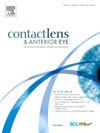不同后视区直径的角膜塑形镜控制近视的疗效:系统回顾和meta分析。
IF 3.7
3区 医学
Q1 OPHTHALMOLOGY
引用次数: 0
摘要
目的:评价不同后视带直径(BOZD)角膜塑形镜控制青少年近视进展的效果。方法:根据PRISMA 2020指南,在PubMed、Web of Science、EMBASE、Cochrane Library、EBSCO、Scopus、Ovid、CBM、CNKI、VIP、万方等多个数据库进行系统检索。纳入标准包括随机对照试验(RCTs)和对照研究,比较角膜塑形镜与各种BOZD设计在青少年近视控制中的有效性。提取相关资料,使用RevMan 5.3进行meta分析,评估偏倚风险。主要结局包括轴长(AL)、球面等效折射(SER)、治疗区直径(TZD)和治疗区面积(TZA)。次要结果包括未矫正距离视力(UDVA)、最佳矫正视力(BCVA)、高阶像差(HOAs)和偏心率(E)。结果:共纳入17项研究,包括12项随机对照研究和6项对照研究。meta分析显示,与传统的BOZD相比,较小的BOZD镜片可显著抑制眼轴伸长(SMD = -0.83, P)。结论:较小BOZD的角膜塑形镜片可有效控制近视进展,改善眼轴伸长、TZD、TZA和SER,增加HOAs,但对偏心率、UDVA无显著影响。本文章由计算机程序翻译,如有差异,请以英文原文为准。
Therapeutic efficacy of orthokeratology lenses with different back optic zone diameters in myopia control: A systematic review and meta-analysis
Objective
This study evaluates the efficacy of orthokeratology lenses with different back optic zone diameters (BOZD) in controlling myopia progression among adolescents.
Methods
Following PRISMA 2020 guidelines, a systematic search was performed across multiple databases, including PubMed, Web of Science, EMBASE, Cochrane Library, EBSCO, Scopus, Ovid, CBM, CNKI, VIP, and Wanfang. Inclusion criteria encompassed randomized controlled trials (RCTs) and controlled studies comparing the effectiveness of orthokeratology lenses with various BOZD designs for myopia control in adolescents. Relevant data were extracted and analyzed using RevMan 5.3 for meta-analysis, assessing the risk of bias. Primary outcomes included axial length (AL), spherical equivalent refraction (SER), treatment zone diameter (TZD), and treatment zone area (TZA). Secondary outcomes included uncorrected distance visual acuity (UDVA), best-corrected visual acuity (BCVA), higher-order aberrations (HOAs), and eccentricity (E).
Results
A total of 17 studies were included, comprising 12 RCTs and 6 controlled studies. Meta-analysis showed that compared to conventional BOZD, smaller BOZD lenses significantly inhibited axial elongation (SMD = −0.83, P < 0.00001), reduced TZD (SMD = −1.38, P < 0.00001) and TZA (SMD = −2.05, P < 0.00001), and improved SER (SMD = 0.81, P < 0.0001) and BCVA (SMD = 0.27, P = 0.04). No significant effects were found on eccentricity (P = 0.79) or UDVA (P = 0.31), while HOAs increased (SMD = 1.01, P = 0.02). Longer follow-ups resulted in more reliable findings.
Conclusions
Orthokeratology lenses with smaller BOZD effectively control myopia progression, improving axial elongation, TZD, TZA, and SER, and increase HOAs, but do not significantly affect eccentricity, UDVA.
求助全文
通过发布文献求助,成功后即可免费获取论文全文。
去求助
来源期刊

Contact Lens & Anterior Eye
OPHTHALMOLOGY-
CiteScore
7.60
自引率
18.80%
发文量
198
审稿时长
55 days
期刊介绍:
Contact Lens & Anterior Eye is a research-based journal covering all aspects of contact lens theory and practice, including original articles on invention and innovations, as well as the regular features of: Case Reports; Literary Reviews; Editorials; Instrumentation and Techniques and Dates of Professional Meetings.
 求助内容:
求助内容: 应助结果提醒方式:
应助结果提醒方式:


